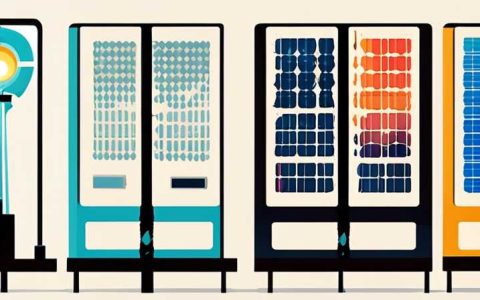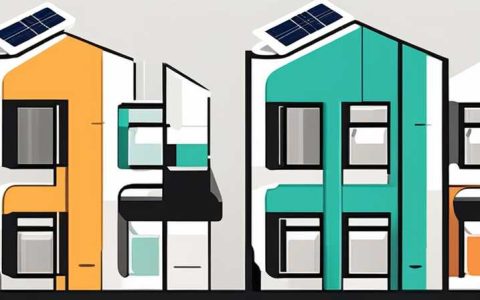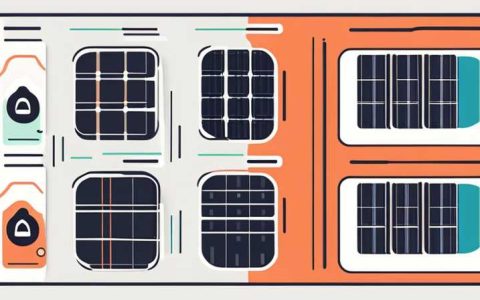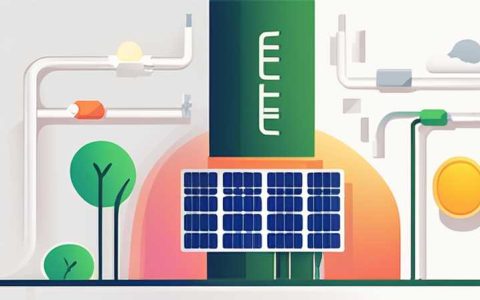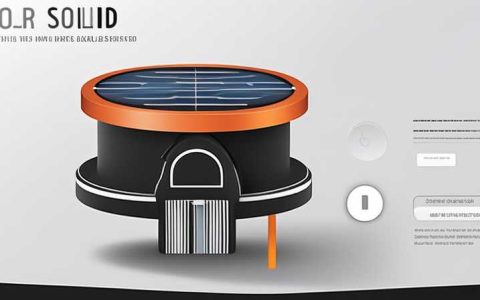
What is a solar energy storage power station?
A solar energy storage power station serves as a facility that integrates solar energy conversion with energy storage systems to manage, store, and dispatch electricity efficiently. 1. It captures solar energy generated by photovoltaic panels, 2. stores the energy for later use, 3. provides a reliable power supply, and 4. enhances the stability of the electrical grid.
The facility typically employs batteries or other storage technologies to hold excess energy produced during peak sunlight hours, releasing it when demand exceeds generation, particularly during nighttime or cloudy conditions. This innovation facilitates the transition toward renewable energy by enabling consistent energy supply, contributing to grid resilience, and reducing reliance on fossil fuels.
1. INTRODUCTION TO SOLAR ENERGY STORAGE POWER STATIONS
Solar energy storage power stations are pivotal in the global shift towards sustainable energy by bridging the gap between energy generation and consumption. These stations harness sunlight through photovoltaic (PV) systems and convert this energy into electricity. However, the intermittent nature of solar energy necessitates a robust energy storage solution to provide reliable power.
The essence of storing solar energy lies in capturing the excess energy produced during sunlight exposure and storing it efficiently for use during low production periods, such as evenings or overcast days. This storage capability is crucial for balancing supply and demand dynamics, ensuring that energy is available when needed without interruption.
2. COMPONENTS OF SOLAR ENERGY STORAGE POWER STATIONS
2.1 Photovoltaic Systems
At the core of every solar energy storage power station are photovoltaic systems, which comprise solar panels that convert sunlight into direct current (DC) electricity. The efficiency of these panels is influenced by various factors, including material quality, angle, orientation, and environmental conditions.
Bifacial solar panels have emerged as a game-changer. Unlike traditional panels, they absorb sunlight from both sides, increasing energy generation by capitalizing on reflected light and improving overall performance under varying conditions. This innovative aspect can significantly enhance the total energy output of a solar power station.
2.2 Energy Storage Systems
Energy storage systems (ESS) are the cornerstone of any solar energy storage power station. These systems store surplus electricity generated during peak hours using various technologies, including lithium-ion batteries, flow batteries, and even pumped hydro storage. Among these, lithium-ion batteries have gained immense popularity due to their high energy density, efficiency, and decreasing costs.
Different technologies suit different applications, presenting a range of options for operators to choose based on specific needs. For example, lithium-ion batteries are well-suited for short-to-medium duration storage, while flow batteries may be more effective for longer-duration applications. Selecting the right ESS is vital for the effectiveness and reliability of a solar energy storage facility.
3. WORKING MECHANISM OF SOLAR ENERGY STORAGE POWER STATIONS
3.1 Energy Capture
The operational mechanics of a solar energy storage power station begins with energy capture. During the day, when sunlight is abundant, solar panels generate electricity that can either be used directly for consumption or routed to the energy storage system for later use. This dual functionality allows power stations to maximize efficiency by catering to varying demand levels.
Devices like inverters play a critical role during this phase by converting the DC output from solar panels into alternating current (AC), which is suitable for use in homes and businesses. This seamless conversion is essential in integrating solar energy into the electrical grid while ensuring compatibility with existing infrastructure.
3.2 Energy Storage and Discharge
Once energy is captured and converted, it can be stored for use at a later time. This phase is facilitated by the energy storage systems, where surplus energy is retained in batteries. The stored energy can be dispatched when sunlight is insufficient, such as during nighttime or overcast days.
This flexibility not only ensures a continuous energy supply to end-users but also stabilizes grid operations by mitigating fluctuations in energy availability. Additionally, during peak demand periods, stored energy can be released back into the grid, thus reducing reliance on fossil fuel power plants and decreasing greenhouse gas emissions.
4. BENEFITS OF SOLAR ENERGY STORAGE POWER STATIONS
4.1 Environmental Impact
The integration of solar energy storage power stations aligns with global efforts to combat climate change. Utilizing renewable energy sources significantly reduces greenhouse gases, contributing to cleaner air and a healthier environment. Solar power systems can operate with minimal ecological disruption compared to conventional energy sources, further amplifying their sustainability.
Additionally, many storage solutions are continuously evolving to enhance recycling capabilities, thereby minimizing waste generated from decommissioned batteries. Innovations in storage technology emphasize circular economy principles, driving environmentally responsible practices across the energy sector.
4.2 Economic Advantages
The financial benefits associated with solar energy storage power stations are substantial. Although the initial investment may be considerable, the long-term savings through reduced energy bills, minimal maintenance costs, and revenue generation through energy sales make these systems economically viable.
Government incentives, tax credits, and subsidies for renewable energy technologies can further enhance the economic attractiveness of solar energy storage projects. Furthermore, as technology advances and competition drives down costs, solar energy storage solutions are poised to become increasingly accessible, leading to falling prices for consumers and enhanced market penetration.
5. CHALLENGES AND CONSIDERATIONS FOR SOLAR ENERGY STORAGE POWER STATIONS
5.1 Technical Hurdles
Despite their numerous advantages, solar energy storage power stations face technical challenges that can impede widespread adoption. Among these challenges, energy loss during storage, battery degradation over time, and the need for reliable system integration with existing electrical infrastructures remain concerns.
Furthermore, the reliance on rare materials for manufacturing batteries can complicate supply chain dynamics and increase vulnerability to market fluctuations. Addressing these technical hurdles requires continual investment in research and development aimed at increasing efficiency, longevity, and reliability across various energy storage technologies.
5.2 Regulatory and Market Dynamics
Navigating the regulatory environment poses another challenge for operators of solar energy storage power stations. Comprehensive regulations are essential for guiding the growth and integration of renewable technologies. However, fragmentation and variability in policies across regions can create uncertainty and hinder investment.
Market dynamics, including energy pricing, grid access, and competition with traditional energy providers, also affect the feasibility and desirability of solar energy storage. To succeed, stakeholders must engage with policymakers and industry participants to advocate for supportive frameworks and encourage innovation.
FREQUENTLY ASKED QUESTIONS
WHAT ROLE DOES ENERGY STORAGE PLAY IN RENEWABLE ENERGY?
Energy storage is crucial in managing the fluctuating nature of renewable sources. It allows for excess energy produced during peak generation periods to be stored for later use. This capability ensures a stable and reliable energy supply, even when generation is low, such as during nighttime or adverse weather conditions. By storing energy, solar energy storage systems help balance the grid and reduce reliance on fossil fuels, leading to greater sustainability. Energy storage technologies vary widely, including battery systems and pumped hydro, allowing for a diverse and adaptable energy landscape.
HOW DOES A SOLAR ENERGY STORAGE POWER STATION IMPACT ELECTRICITY PRICES?
The widespread adoption of solar energy storage power stations can lead to lower electricity prices in several ways. By enabling a stable supply of renewable energy, these systems reduce dependence on costly fossil fuel sources during peak demands. Furthermore, energy storage allows utility companies to manage demand more effectively, lowering the need for expensive peaker plants. As competition drives down the costs of solar technology and storage solutions, consumers can realize significant savings on their energy bills, contributing to overall reductions in electricity prices.
ARE SOLAR ENERGY STORAGE POWER STATIONS SUITABLE FOR ALL LOCATIONS?
While solar energy storage power stations offer significant advantages, their suitability can vary by location due to several factors. Regions with abundant sunlight and supportive policies tend to be more conducive for such facilities. However, areas with less solar exposure may need to couple solar energy with more robust energy storage solutions or complementary renewable sources, such as wind energy. Additionally, local regulations, grid infrastructure, and available financial incentives will influence the practicality of implementation, requiring careful planning and assessment before deployment.
The advent of solar energy storage power stations represents a transformative shift in how energy is generated, maintained, and consumed. The outlined benefits prompt a re-examination of energy sourcing, as reliance on fossil fuels diminishes in favor of renewable solutions. By integrating solar energy and robust storage technologies, communities become more resilient while protecting the environment. Strategic investment and policy support are essential to foster this transition, encouraging innovation and expanding the accessibility of renewable energy technologies. Challenges remain, but addressing them will pave the way for a sustainable energy future that benefits not only the current population but also subsequent generations. Ultimately, the evolution of solar energy storage power stations plays a pivotal role in combating climate change and ensuring a robust energy landscape.
Original article by NenPower, If reposted, please credit the source: https://nenpower.com/blog/what-is-a-solar-energy-storage-power-station-2/

